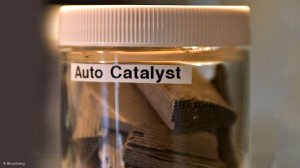JOHANNESBURG (miningweekly.com) – If South Africa was serious about platinum beneficiation it had no choice but to put in place a platinum exchange, investment company Pan-African Capital Holdings CE Dr Iraj Abedian said on Tuesday.
Speaking at a workshop convened by the Mapungubwe Institute for Strategic Reflection (Mistra), Productivity SA and the Ntonga Institute, he pointed out that the country had a predominant share of global platinum reserves, which meant that the global commodity cycle would continue to drive South Africa’s business cycle.
“For as long as South Africa remains a significant producer of platinum-group metals (PGMs), [its economic] cycle and the global cycle will remain the same,” he stated, adding that private and public stakeholders would, therefore, be vulnerable in terms of market “boom-bust cycles”.
However, the country’s national interest dictated that a smooth continuity of platinum supply be available, providing a platform for long-term profit maximisation.
Also speaking at the workshop, Mistra executive director Joel Netshitenzhe said it would be in the country’s best interest to establish a forum to ensure the guaranteed supply of PGMs on time and at a reasonable price in line with production costs.
Abedian said these objectives could be met through a platinum exchange, which he defined as a coordinated market price-discovery, real-time information platform based on voluntary participation.
“A well-functioning exchange smoothes the supply and demand side of the market,” he explained.
Further, through the establishment of a platinum exchange, South Africa could move from the core beneficiation of platinum, or the processing of ore, to a model of integrated beneficiation, where benefits would be derived through the entire value chain, including the financial sector.
PLATINUM EXCHANGE STRUCTURE
Abedian stressed that a platinum exchange would be a market mechanism structured and managed by the private sector, as opposed to being a marketing board.
Further, a platinum exchange would have complex physical and financial components, he said, stating that it was in this complexity that beneficiation would truly take place. “How we manage this complexity is absolutely critical for gaining the benefits of any commodity exchange,” he added.
He pointed out that the concept of commodity exchanges was not new.
“It is also important to note that, unless we move with all the complexities that are involved, to graduate from a mindset of what we know in the commodity markets to what we should be doing. . .we will not benefit from the beneficiation of this asset,” he said.
Further, he stated that any exchange, or market price-discovery mechanism to be established should have stability built into it.
Abedian added that, while government would be a stakeholder in a metal exchange, it could not be a shareholder; however, platinum producers would have the option of investing in the exchange should they want to do so.
Nevertheless, the success of a platinum exchange would depend on the participation of the majority of South Africa’s platinum producers in terms of supplying it with material.
Meanwhile, JSE commodities specialist Anelisa Matutu said such a platinum exchange could potentially be located within the JSE, stating that the stock exchange already had the necessary trading infrastructure.
“All we need is the demand for the [physical] contracts from suppliers and buyers,” she said.
Matutu explained that the JSE did currently have platinum contracts listed; however, these were cash-settled and not physically settled, which meant that when the contracts expired, the agreed upon amount was given to the buyer in cash, as opposed to the buyer receiving the physical platinum.
“We would need support from the suppliers and the buyers of platinum to work towards physically delivered contracts, [but] it is possible,” she said.
Further, she added that it would also be possible for the JSE to have a virtual trading platform for a platinum exchange with different delivery points for the physical platinum.
“That is what we are doing now with our agricultural products. At the JSE, we have the trading platform and we have about 90 delivery locations around South Africa to deliver the products, so we could actually use the exact same model [for platinum],” Matutu said.
WAY FORWARD
Abedian stated that South Africa’s share of platinum resources required serious policy positioning, with a careful regulatory regime needed to facilitate the “spot market” and “future market” contracts of a platinum exchange.
However, he stated that South Africa’s policy makers and government officials were not yet “in the game” and, therefore, serious discussions would be needed to facilitate the establishment of an exchange.
He added that, currently, the top executives of mining companies were also not yet on board in terms of establishing an exchange, as most executives were only focused on the next five to ten years, as opposed to on the longer term.
Therefore, meaningful interaction with industry was also needed.
Also attending the workshop, platinum producer Lonmin marketing head Wilma Swarts indicated that Lonmin would be interested in participating in discussions on a potential platinum exchange and finding a sustainable way forward for the South African platinum industry.
She added that Lonmin would like to see Mistra set up a committee to investigate the business case for such an exchange.
This view was echoed by representatives from mining companies Impala Platinum and Anglo American.
EMAIL THIS ARTICLE SAVE THIS ARTICLE
To subscribe email subscriptions@creamermedia.co.za or click here
To advertise email advertising@creamermedia.co.za or click here











